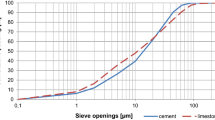Abstract
This paper describes an investigation on creep behaviour of cement bonded particleboards loaded in bending, with special reference to the influence of humidity and temperature (tropical and temperate climatic conditions).
Zusammenfassung
Diese Artikel berichtet über Untersuchungen des Kriechverchaltens von Zement-gebundenen Spanplatten unter Biegebeanspruchung. Besonders berücksichtigt wurde dabei der Einfluß der Feuchte und der Temperatur (entsprechend den Bedingungen in tropischen und gemäßigten Zonen).
Similar content being viewed by others
Literature
Altmann, K.; Dempke, H. 1981: Über den Feuchtigkeitseinfluß auf die Biegefestigkeit und den Elastizitätsmodul von Duripanel. Gutacten Nr. 133/1. Technischen Universität Berlin
Armstrong, L.D.; Christensen, G.N. 1961: Influence of Moisture Changes on Deformation of wood under stress. Nature 191:4791
Armstrong, L.D.; Grossmann, P.U.A. 1972: The Behavior of Particle Board and Hardboard Beams during Moisture Cycling. Wood Sci. Technol. 6:128–137
Clouser, W.S. 1959: Creep of small wood beams under constant bending load. U.S. Forest Products Laboratory, Report no. 2150, Madison, Wis., USA
Davidson, R.W. 1962: The influence of temperature on creep in wood. Forest Prod. J., p. 377–381, August
Dinwoodie, J.M.; Paxton, B.H.; Pierce, C.B. 1981: Creep in Chipboard Part 3: Initial Assessment of the influence of Moisture Content and Level of Stressing on Rate of Creep and Time to Failure. Wood Sci. Technol. 15: 125–144
Dinwoodie, J.M.; Paxton, B.H. 1989: Cement Bonded Wood Particleboard—A Technical Assessment. Construction and Building Materials, 3:14–21
Gerhards, C.C. 1980: Effect of Temperature and Moisture Content on Duration of Load Characteristics of Lumber. Paper presented at the workshop of research needs on effect of the environment on design properties of lumber, Forest Products Laboratory, Madison, Wisconsin, May 28–30
Grossmann, P.U.A. 1976: Requirements for a model that Exhibits Mechano-Sorptive Behavior. Wood Sci. Technol. 10:163–168
Haygreen, J.; Sauer, D. 1969: Prediction of Flexural Creep and Stress Rupture in Hardboard by Use of a Time-Temperature Relationship. Wood Science 1 (4) 241–249
Hoffmeyer, P.; Davidson, R.W. 1989: Mechano-Sorptive creep mechanism of wood in compression and bending. Wood Sci. Technol. 23:215–227
Kollmann, F. 1960: Die Abhängigkeit der elastischen Eigenschaften von Holz von der Temperatur. Holz Roh- Werkstoff 18:308–314
Kondrup, C. 1988a: Creep and Duration-Of-Load of Cement Bonded Particleboard. In Danish (Cementsp⇘npladers krybning og mekanisk levetid). Rapport for Erhvervsforskeruddannelse EF182. The Danish Academy of Technical Sciences
Kondrup, C. 1988b: Cement Bonded Partieleboard—Production, Properties, Utilization. In Danish (Kort om Cementsp⇘nplader). Rapport for Erhvervsforskeruddannelse EF182. The Danish Academy of Technical Sciences
Krebs, H.J. 1984: Rheological Properties of Wood, with special reference to the influence of moisture content. In Danish (Vandind-holdets betydning for træs mekaniske langtidsegenskaber). Lab. for Bygningsmaterialer, Teknisk Rapport 105/84, Building Materials Laboratory, the Technical University of Denmark
Nielsen, A. 1972: Rheology of Building Materials. National Swedish Building Research, Db
Nielsen, L.F. 1984: Power low creep as related to relaxation, elasticity, d damping, with special reference to wood. Teknisk rapport 144/84, Lab. for Bygningsmaterialer, DTH, Building Materials Laboratory, the Technical University of Denmark, Proceedings IUFRO meeting, Mexico
Pierce, C.B.; Dinwoodie, J.M.; Paxton, B.H. 1979: Creep in Chipboard; Part 2: The use of fitted response curves for comparative and predictive purposes. Wood Sci. Technol. 13:265–282
Ranta-Maunus, A. 1972: Viscoelasticity of Plywood under Constant Climatic Conditions. Technical Research Centre of Finland, Building Technology and Community Development, Publication 3
Ranta-Maunus, A. 1973: A Theory for the Creep of Wood with Application to Birch and Spruce Plywood. Technical Research Centre of Finland, Building Technology and Community Development, Helsinki
Ranta-Maunus, A. 1976: A Study of Creep of Plywood. Structural Mechanics Laboratory, Report 5, Espoo August 1976. Technical Research Centre Centre of Finland
Schniewind, A.P.: Über den Einfluß von Feuchtigkeitsänderungen auf das Kriechen von Buchenholz quer zur Fazer unter Berücksichtigung von Temperatur und Temperaturänderungen. Holz Roh-Werkstoff 24:87–98
Author information
Authors and Affiliations
Rights and permissions
About this article
Cite this article
Kondrup, C. Creep of cement bonded particleboard with special reference to the influence of humidity and temperature. Holz als Roh-und Werkstoff 48, 31–35 (1990). https://doi.org/10.1007/BF02607851
Issue Date:
DOI: https://doi.org/10.1007/BF02607851




